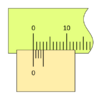It is my opinion that excessively short trim lengths are relatively unimportant. As long as the case neck will hold the bullet, the cartridge will go bang, the bullet will exit the barrel, and nothing bad will happen. Now if the case neck is so short the bullet falls off in the magazine, or feeding, then I would consider that bad.
I am more worried about over length. A case neck that is too long will pinch the bullet in the throat, and I did have over pressure cases because the cases were too long. This happened when I first started reloading, and a Sears cernier caliper was $70.00!. That is like $240 dollars in todays' money. A dial caliper was over $100. To read the vernier, I had to use a magnifying glass, and it took too much time for impatient me.

vernier scale from Wiki
So I decided that it was un necessary to trim once fired cases, out of the fallacious idea that new meant they would not grow on first firing. It turns out, new cases are always over length on first resizing. Opps!
Take a look at this gauge, which is cut using a SAAMI minimum chamber reamer. Can you see the black gap between case mouth and the throat?. That is the clearance between the case mouth and the throat, so in this example, I have a lot of clearance between the case mouth and throat, and the likely hood of the mouth being pinched in the throat, is very, very small.

Having shot ammunition like this all way out to 600 yards, and having good groups that hold the ten ring at 300 yards, and mostly at 600 yards, I am not concerned about any theoretical accuracy deterioration. The wind blows me more around at distance than case length OAL.

this was a good load


Just fill your wheel barrow with all those bench rest reloading techniques you read on the web, and dump them on the composite heap. It is far more important to make safe, reliable ammunition that feeds and extracts every firing. And, you will find out, if the barrel, bullet, and bedding are good, the ammunition will shoot pretty good.






